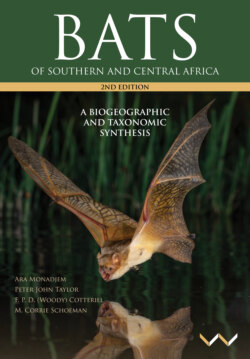Читать книгу Bats of Southern and Central Africa - Ara Monadjem - Страница 59
На сайте Литреса книга снята с продажи.
ОглавлениеEpomophorus grandis (Sanborn 1950)
Sanborn’s epauletted fruit bat Data Deficient
Description: Despite its name, Epomophorus grandis is a medium-sized bat (and small for a fruit bat) with an estimated mass of 50–60 g. The pelage is light brown; the individual hairs are uniformly coloured (Hayman 1963). It is assumed that, as a member of the genus Epomophorus, adult male E. grandis will display white shoulder epaulettes; however, to date only two young males have been collected, neither of which had these patches (Bergmans 1988). The ears have a patch of white fur at their base. The muzzle is dog-shaped.
The dental formula is 2121/2132 = 28. There are six narrow palatal ridges present, with the second to the sixth divided by a narrow groove (Sanborn 1950). One ridge is present beyond the last molar.
Key identification features: The combination of white patches at the base of the ears and shoulder epaulettes (males) separates Epomophorus, Epomops and Micropteropus from other fruit bats. Palatal ridges of Epomops and Micropteropus are very different from those of Epomophorus; in the latter there are six narrow ridges (five thick ridges in Micropteropus and Epomops). Epomophorus grandis can be distinguished from sympatric E. wahlbergi by its much smaller size (FA < 70 mm; in E. wahlbergi FA > 75 mm). Epomophorus grandis is the same size as E. labiatus and E. anselli, but in the last two species, the second to fourth palatal ridges are undivided (second to sixth palatal ridges divided in E. grandis).
| External measurements (mm) for Epomophorus grandis, sexes combined | |||||
|---|---|---|---|---|---|
| Mean | Min | Max | SD | N | |
| Mass | - | - | - | - | - |
| FA 1 | 63.6 | 62.3 | 65.8 | - | 3 |
| Total 1 | 99.0 | - | - | - | 1 |
| Tail 1 | 5.7 | 3.8 | 7.5 | - | 2 |
| Tibia 1 | 28.1 | 27.3 | 28.7 | - | 3 |
| Ear 1 | 16.9 | 16.0 | 17.5 | - | 3 |
| CI | - | - | - | - | - |
1 Bergmans (1988)
Echolocation call: This bat does not echolocate.
Distribution, habitat and roosting: Epomophorus grandis is known from only four specimens collected at two localities in Angola and Congo (Bergmans 1988). It is probably more widespread than suggested by these two localities. It may occur throughout northern Angola and possibly the western DRC and Congo. The type specimen is from Dundo, northeastern Angola (FMNH 66433, Holotype).
This species appears to be associated with a mosaic of lowland rainforest and secondary grassland (Bergmans 1988), suggesting that it will not be found to occur in primary rainforest to the north of its known range, but may occur in the Guinean–Congolian/Zambesian Transition Zone between forest and savanna to the south.
Extralimital: Epomophorus grandis is a near-endemic to southern Africa, occurring marginally outside of it in the extreme southwest of Congo.
Foraging ecology: There is no information on the diet or foraging behaviour of this species.
Reproduction: No reproductive information is available.
SYSTEMATIC NOTES
1950.Micropteropus grandis Sanborn, Chiroptera from Dundo, Lunda, northeastern Angola. Publções cult. Co. Diam. Angola 10: 53–62.
Epomophorus grandis was originally described as Micropteropus grandis; the other two members of that genus are much smaller, hence the epithet ‘grandis’. Ironically, it is one of the smallest members of the genus Epomophorus. Micropteropus is maintained as a distinct genus by Bergmans (1988), based on the configuration of palatal ridges: five in Micropteropus and six in Epomophorus. Furthermore, in Micropteropus, the palatal ridges are thick, with the second to the fifth deeply divided by a groove. In Epomophorus, the palatal ridges are narrow, with only the fifth and sixth marginally divided. However, in E. grandis, the palatal ridges are narrow (as is typical of Epomophorus), but the second to the sixth are divided (as in Micropteropus).
1 Bergmans (1988)
